About Ships Types
For any amateur or even the general public, a warship type is always a pre-requisite after naming that a ship is indeed “a warship”. The question of this nature is obvious at first: A warship is intended for warfare. It’s a primary purpose and everything in its design and conception, equipment and crew training must tend to this objective.
However, this nature was at the first, at the birth of the “ship” itself, not quite obvious, and it remained sometimes blurry all along millenias before the 19th century. Indeed what distinguish a raft, a dugout or a canoe in its military use ?
It is well solidified now, as more technology pushed for more specialization, and composite construction allowed more complex ships, but still, civilian ships were impressed with navies in times of war, and either converted or armed. From the Viking longships, which also carried goods and most Medieval vessels, up to the Galleons and Indiamans which carried heavy loads in addition to their armament, to the fake gun ports painted on XIXth century vessels, the line was blurry indeed.
In wartime, WW1 and WW2 converted commerce raiders, armed merchant cruisers, armed trawlers, armed troop transports, were all warships in use and function, in addition or replacement to their original function (like for the armed trawlers which patrolled for submersibles). But these were the exceptions. Warship type was in principle well defined, but changed in nature over time.
So how to define ships types in history ?
A definition of a warship to start with, using ChatGPT for the fun of it:
“A warship is a type of naval vessel designed and built for military purposes. Warships are used primarily for naval warfare, which can include a range of activities such as enforcing blockades, conducting amphibious operations, and engaging in battles with other ships or submarines.
Warships come in a variety of sizes and types, ranging from small patrol boats to massive aircraft carriers. They are equipped with a range of weapons systems, including guns, missiles, torpedoes, and depth charges, and are designed to withstand damage from enemy attacks.
Some of the most common types of warships include:
Battleships: Large, heavily armed and armored warships designed to engage in battles with other ships.
Aircraft carriers: Large, flat-decked ships that carry and launch fighter planes and other aircraft.
Destroyers: Fast, maneuverable warships designed to protect larger ships and engage in anti-submarine warfare.
Submarines: Underwater vessels that are capable of launching torpedoes and missiles.
Frigates: Smaller warships that are typically used for escort duty and anti-submarine warfare.
Warships play a critical role in modern naval warfare, and are designed and built using the latest technologies and materials to ensure that they are capable of carrying out their missions effectively and safely.”
Thus, based on world wide data, the simple definition of a warship immediately conduct to the type definition: A warship is defined by its shape AND function. A ship of the line for example was so loaded with guns it could would have performed poorly for commerce. And so is a battleship, the ultimate warfare specialist.
So let’s have a look at these specializations and classifications over time:
Antique ship’s types
The Merchant Cargo ships
Alonsgside very small and simple boats like rafts and dugouts, pelt and basket-boats, ports saw the visit of commerce vessels. Those of the classic age came from Phoenician experience, credited to have invented the keel and a new construction technique enabling off-shore travel. The small vessels still travelled while keepin the coast in sight and usually stopped on a beach for the night. This did not changed much until the renaissance, when new astrological and calculation devices enabled long-range, oceanic navigation for the first time. These small commerce vessels were about 15-20 m long with a single large square sail and mast, but over time they grew in size, up to the massive Roman Corbitas at the borth of the Christian era.
Were these ships be converted for war ? Of course they could carry troops, archers, and proceed to boarding actions. But in no way were they comparable to a typical “long ship”, the term used to describe warships for millenias.
As for types, let’s cite the:
-Gaulos: Typical Phoenician trade ship
–
-Corbita: Typical “grain cargo” of Rome
The antique warship: Classification by rowers
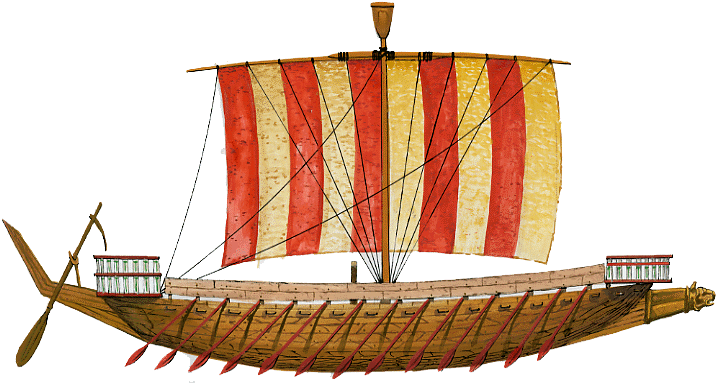
A “Kepen”, which could means “warship” in classic Egyptian.
For an untrained eye a typical greek galley is the epitome of the classical era as was the Hoplite and his crested helmet. The term “galley” is apocryph here. In reality the ancient greeks spoke of “akation” for a boat and more precisely “aphraktoi” and “kataphraktoi” to ditinguish about their size in a quick way; More definitions here and here. The Romans had a simpler term, “nave” which gave use “naval” and everything related. These were long, narrow, often single-decked ships powered by rowers which took most of its useful space, with little room to spare. Masts and sails were only used in harbours and for long crossings, to spare the rowers, but never in battle. These caracteristics made them clearly identified, before even going into more details (like the presence of a ram).
The absolute classic was the trier/trireme, the Romans (newcomers to sea) adapted as “triremis”. This came from the number of rowers. On this base, many heavier types were so classified, which gives us the following:
-moner: small ship with a few rows, used for daily coastal transportation and liaison
-cisokonther: Larger type with at least 15-20 rowers per side, basic bronze age military ship. Gave birth centuries later to the Hellenistic Lemboi and Roman liburnae derived from pirate ships
-pentakonther: The largest classic warship, likely late bronze age. 25 rowers per side, 50 in all. Used until the dier appeared.
-dier (diērēs): Still 25 rowers or even 30, but in staggered bunks, making look like they had two rowing lines superposed. The new standard invented by the Phoenicians. Roman Biremis.
-trier (triērēs): The classic “three-rowed” invented probably by Ameinocles for the Corinthian Navy (still hotly debated). Which is not is the importance that take that new warship in maritime affairs in the classic age, from 800 BC, up to the end of the Hellenistic age in around 32 BC (After the Battle of Actium). They ensured notably the domination of Athens and were featured prominently in all naval battles of the time.
Tetrer (tetrērēs): The first hellenistic “super warship”, designed for speed, but of which rowing variations were unknown between two rows and two rowers each, or two rowers on the upper row (still 3 rows). Also the first “kataphraktoi”. Roman Quadrireme.
Penter (pentērēs): The “new standard” of the Hellenistic age. More powerful in ramming, it had five rowers per side, likely in three rows (2-2-1). Full decked to be armed with catapeltes and lithoboloi among others and more troops. Roman Quinquireme, the core of Pompey’s fleet when he pacified the Mediterranean against piracy during the Roman civil wars.
Dekere (dekērēs): The “ten” (there were intermediate ships like the Hepter which met success), generally used as floating HQs. End the Hellenistic era.
Hekkaidekere: The “40”, an absolute monster of which little is really known, more floating palace than warhip, Ptolemaic Empire.
The medieval era
A long transition seeing the rise of the viking age and consolidation of the galley in the Mediterranean. There is a flurry of new types, able to perform often both military missions and warfare. Those were just standard vessels equipped with platforms or early “castles” for bowmen fore and aft. This was the pre-gunpowder age, fights were done at range and by boarding. In scale, they went nowhere near the large naval battles of the antiquity. Here are some of these types:
-Clinker: (small oak-built vessel)
-Kog: The great standard of the time)
-Hulk: A larger multi-masts transitional ship)
-Nava: The Mediterranean equivalent
-Langskip: The archetypal versatile raiding/commerce vessel of the scandinavians, many sub-types existed in reality, but none called “drakkar”.
-Carrack: The late medieval/renaissance warship, also usable for trade and transport, inaugurating the gunpowder age.
The Renaissance era
(To come)
The Imperial/Enlightenment Era
(to come)
About classes and standardization
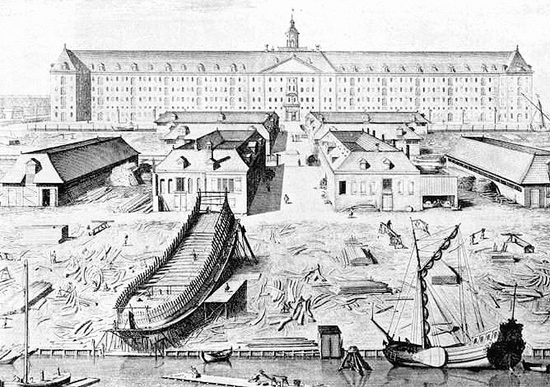
The 18th century’s “74 cannon” for example was a well-known sailing ship of the line type, but apart the number of guns it is difficult to establish a “class” per se, as each yard had its own more or less empriric calculations, resulting in many diverging types even in the yard itself, from a Royal order asking for twenty “74 cannons”. But standardization always existed to some degree. A good example would be the first punic war.
The Romans, which were complete strangers to naval matters, turned to Magna Grecia to have a large fleet very rapidly built, so quick historians had doubts about it for a long time, that is before a discovery: Indeed a rare punic wreck showed that all parts were marked with precise cotations. This was interpreted by mass production already thought of, as every ship was a essentially a jigsaw puzzle, with masses of similar parts coming in for final assembly. And as few ships really sunk at the time, most were captured or just ended washed on shore. They would be cannibalized to replace damage parts or reconstruct a new ship from several wrecks.
In the medieval era, there were specialized types, but again, the ships could diverge due to many factors, notably the will of the local governor to commit his finances in some cases. Ships could also be private funded. If in the ancient Athens, Salamine’s Greek fleet was financed in great part by the Laurion mines, decided by the ruling class, but still the ships were maintained by private owners and captains loaned. Thus, without attested centralized state supervision (again the Carthaginians probably had an edge on this), they could diverge considerably from a yard to the next.
Local Scandinavian warlords ordered ships in single units and for specific purpose rather than entire fleets, which for expeditions were conglomerates of various chieftain’s own private fleets. Powerful trade companies like the Baltic leagues, Italian city-states also built ships in units rather than classes. Standardization in the end mostly came from the constitution of powerful nation states in Europe. Only kings and Emperors of these early Empires could order to many yards a specific type of vessel for the fleet. The creation of a navy ministry also helped on this, for planning long-term (notably forest management).
However even in that case, the types did not equate classes. For example during the Russo-Swedish wars of the early 18th century, the Swedes committed a variety of “archipelago frigates” scientifically designed by a renoewn architect and well adapted to the Baltic, which bore specic names and were well identified, such as a Hemmema and others. But this does not equate a class, as each yard responsible for their construction made them on their own plans again, and they diverged in countless details. Centralization in ordnance still appeared in the same century and the enlightenment age pressed forward for a globally more scientifical approach to naval construction and to get rid of empirism alone. The sharing of knowledge, notably through the creation of the encyclopediae, with the involvment of mathematicians and specialists born from a solid university network drove this standardization, which peaked in the XIX Century.
Indeed, nothing but industrial standardization of the XIXth century made a “class” no longer poetry but a reality. Casting, bolts and rivets, as well as new manufacturing processes and techniques guaranteed consistent sub-parts. Entire, complex and large ships could be entirely duplicated. At last several classes in a single type could be identified and registered. In the civilian and military sectors alike. RMS Titanic for example belongs to the same class of three ships ordered by the White Star Lines: The Olympic class.
About Naming and Dates
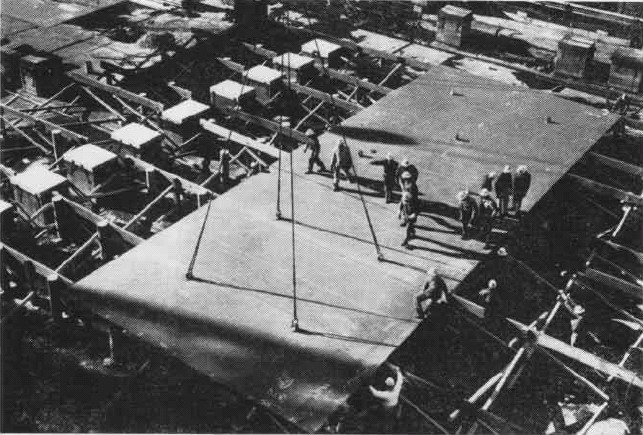
A “modern” keel laying
A human being is a unique living entity, but still, given two names and two dates: One of birth, and a name within a family (“last name” in anglo-saxon culture, coming after the forename, and inverted in Asian cultures) and one of decease. But what about ships ?
A ship had a no less than six dates (universally agreed and most important):
A ship’s most important days
–An order day (chosen by an elected government or by executive order after the naval staff’s acceptation of a design, and after funds are secured in a parliament in general)
–A laying down day: in the XXth, a call to offer was done by the admiralty on specifications towards existing yards, national or foreign for a market of one or several ships. When a yard was selected, a place was chosen and the keel laid down. In some case, if the ship was important enough, there was a ceremony.
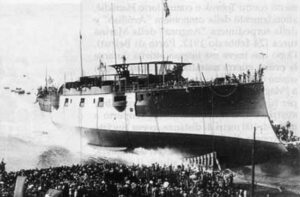
–A launch day: The main date for a ship, anthropologically assimilated to a birth. From the keel laying to this, it can be loosely seen as a foetus-like development. The launch (the day a completed hull was put at sea for the first time) was always a grand ceremony, at least for important vessels. In wartime for mass-produced ones, less so. A woman was chosen to bless the ship (often in relation to the ship’s name) by breaking a bottle on its prow, a very ancient tradition now becoming an international standard. It was a sign of good luck, notably ensuring the safe return of husbands to their wives. A coin was also often planted under the mainmast base in the wooden ship tradition, and its often still used in modern construction.
–A completion day: A bit less important, when the yard completed the ship at berth, using cranes to assemble what was left of the internals and superstructures. The completion was the finished state (all in place, ready for trials) before any load could be carried, including for example, ammunitions, food for the crew, and tons of long-term use equipments. Anthropomophically, early infancy. This does not means the ship is ready yet.
–The first commission day: The day she ship is accepted by the Navy, with a flag raised, and a ceremony held, ready to depart for initial training. In between what happened ? The ship needed to be tested all around, first in the yards, harbour, for initial trials, and then official sea trials for acceptance. If problems are signalled, the ship returned to the yard for adjustments until new trials are held, and acceptance. This is the baby’s first steps, up to be able to run.
Next is the active life of the ship. The infancy (initial and advance training, gunnery and torpedo drills, air group qualifications for an aircraft carrier, etc.) School time. And it was cut by periods of upkeep, crew’s rest, replenishment, fxies, overhauls, all in peacetime. In wartime, it’s the time of suffering and live action, aldulthood. Then, slow decline, with still overhauls. After 30-40 years a ship is considered worn out, depending of its active life and general maintenance. It can suffer also from collisions and running aground, or storm battering. Somewhat like good healthy cells, a well-drilled, motivated crew can save it’s ship in the worst situations. It was proven time and again in wartime.
–A final decommission day: The ship has spent its potential, and is due to retirement for various reasons, but most often obsolescence. The technology moved on and there are limits to upgrades, in capabilities and cost. When a ship is decommissioned (for the last time, may be many in between for overhauls or reserve, in which the crew is absent). It is by no means the date of “disappearance” of a ship. Afterwards, the Navy generally sell the ship on auction for its material value after it is stricken from the naval register. But some can be still used in other ways, adding many years to their useful life, as floating barracks, stationary schoolship, floating HQ, even jail back in the old days, depot ship, crane ship, transport, etc. If a hull was robust enough, nothing impossible for a ship to last for more decades, even a hundred years (talk for human retirement). If not, it could be “spent” as gunnery or other ordnance’s target. In some case to even create an artificial coral reef. But most ends in a scrapyard, broken up and recycled, with some memorabilia saved for display and in rare (and enviable) cases, ending as a museum ship.
A sinking date: As for the ones sunk in action or scuttled (a suicide in human terms), they can only be in rare cases refloated again. Most of the time they end in the depths, sometimes never found, sometimes after decades; What does not change is their fate as wrecks: They can be explored (with authorization) but certainly not plundered, as miliitary ships sunk in action are declared war graves and protected by international conventions.
Why these dates are important ?
Because they defines the class name and associated date.
A “class”, as seen above, is a serie of standardized ships, from the same design. Sometimes variations can be important enough in a serie to end as a “sub-class”. But the name chosen for a class was a matter for debate for decades, until a universal standard was adopted. In the late XIXth, the American tradition was to name a ship after its launch day while in Europe it was after its completion date. The former eventually became the accepted standard, as the “birth” of the lead ship in a serie, which gave her name to the serie itself. Since completion and launch dates are not the same and due to construction delays the second ship laid down can be the first launched or completed, classes bore different names, especially in old publications.
Now the general consensus accepted by all for better communication is the launch date of the first vessel in the serie (and its name), even if laid down later and/or completed later than another.

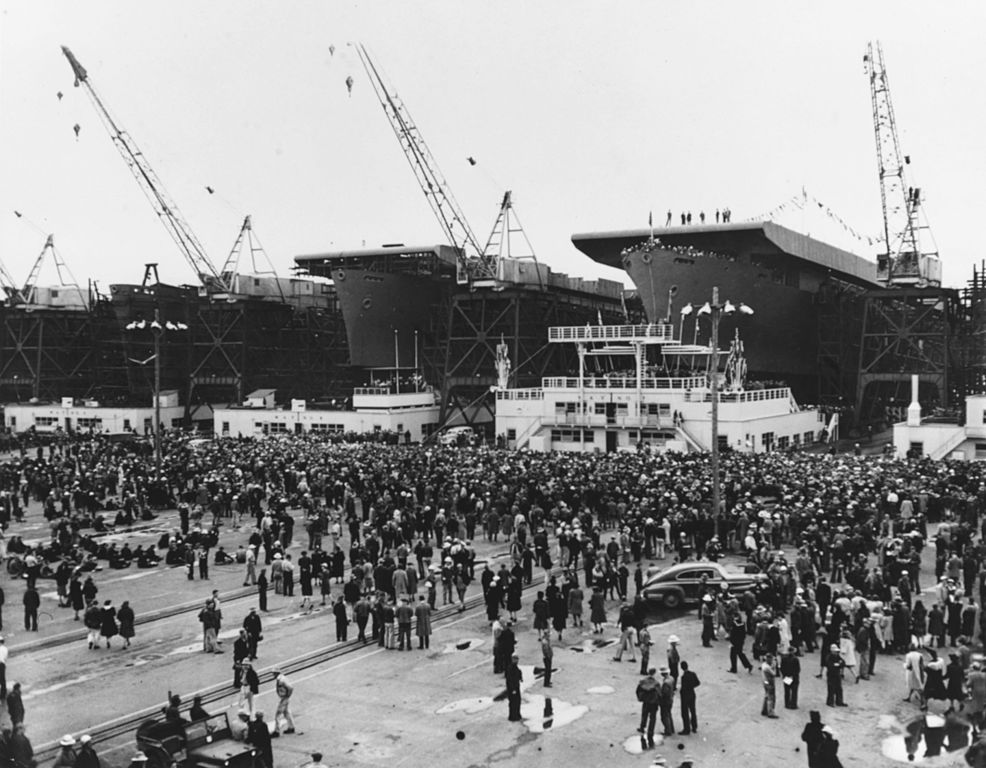
 Latest Facebook Entry -
Latest Facebook Entry -  X(Tweeter) Naval Encyclopedia's deck archive
X(Tweeter) Naval Encyclopedia's deck archive Instagram (@navalencyc)
Instagram (@navalencyc)





 French Navy
French Navy Royal Navy
Royal Navy Russian Navy
Russian Navy Armada Espanola
Armada Espanola Austrian Navy
Austrian Navy K.u.K. Kriegsmarine
K.u.K. Kriegsmarine Dansk Marine
Dansk Marine Nautiko Hellenon
Nautiko Hellenon Koninklije Marine 1870
Koninklije Marine 1870 Marinha do Brasil
Marinha do Brasil Osmanlı Donanması
Osmanlı Donanması Marina Do Peru
Marina Do Peru Marinha do Portugal
Marinha do Portugal Regia Marina 1870
Regia Marina 1870 Nihhon Kaigun 1870
Nihhon Kaigun 1870 Preußische Marine 1870
Preußische Marine 1870 Russkiy Flot 1870
Russkiy Flot 1870 Svenska marinen
Svenska marinen Søværnet
Søværnet Union Navy
Union Navy Confederate Navy
Confederate Navy Armada de Argentina
Armada de Argentina Imperial Chinese Navy
Imperial Chinese Navy Marinha do Portugal
Marinha do Portugal Mexico
Mexico Kaiserliche Marine
Kaiserliche Marine 1898 US Navy
1898 US Navy Sovietskiy Flot
Sovietskiy Flot Royal Canadian Navy
Royal Canadian Navy Royal Australian Navy
Royal Australian Navy RNZN Fleet
RNZN Fleet Chinese Navy 1937
Chinese Navy 1937 Kriegsmarine
Kriegsmarine Chilean Navy
Chilean Navy Danish Navy
Danish Navy Finnish Navy
Finnish Navy Hellenic Navy
Hellenic Navy Polish Navy
Polish Navy Romanian Navy
Romanian Navy Turkish Navy
Turkish Navy Royal Yugoslav Navy
Royal Yugoslav Navy Royal Thai Navy
Royal Thai Navy Minor Navies
Minor Navies Albania
Albania Austria
Austria Belgium
Belgium Columbia
Columbia Costa Rica
Costa Rica Cuba
Cuba Czechoslovakia
Czechoslovakia Dominican Republic
Dominican Republic Haiti
Haiti Hungary
Hungary Honduras
Honduras Estonia
Estonia Iceland
Iceland Eire
Eire Equador
Equador Iran
Iran Iraq
Iraq Latvia
Latvia Liberia
Liberia Lithuania
Lithuania Mandchukuo
Mandchukuo Morocco
Morocco Nicaragua
Nicaragua Persia
Persia San Salvador
San Salvador Sarawak
Sarawak Uruguay
Uruguay Venezuela
Venezuela Zanzibar
Zanzibar Warsaw Pact Navies
Warsaw Pact Navies Bulgaria
Bulgaria Hungary
Hungary

 Bundesmarine
Bundesmarine Dutch Navy
Dutch Navy Hellenic Navy
Hellenic Navy Marina Militare
Marina Militare Yugoslav Navy
Yugoslav Navy Chinese Navy
Chinese Navy Indian Navy
Indian Navy Indonesian Navy
Indonesian Navy JMSDF
JMSDF North Korean Navy
North Korean Navy Pakistani Navy
Pakistani Navy Philippines Navy
Philippines Navy ROKN
ROKN Rep. of Singapore Navy
Rep. of Singapore Navy Taiwanese Navy
Taiwanese Navy IDF Navy
IDF Navy Saudi Navy
Saudi Navy Royal New Zealand Navy
Royal New Zealand Navy Egyptian Navy
Egyptian Navy South African Navy
South African Navy






























 Ukrainian Navy
Ukrainian Navy dbodesign
dbodesign